When it comes to tourism in Jiangxi, Sanqingshan is a must-mention. It, together with Lushan Mountain, Jinggang Mountain, and Longhushan Mountain, forms the four famous mountains for tourism in Jiangxi. It is a world natural heritage site. Its natural landscape is highly similar to that of Huangshan Mountain. Its high-altitude plank roads are truly remarkable. There is a lot of Taoist culture worth exploring. Today, let’s briefly sort it out.
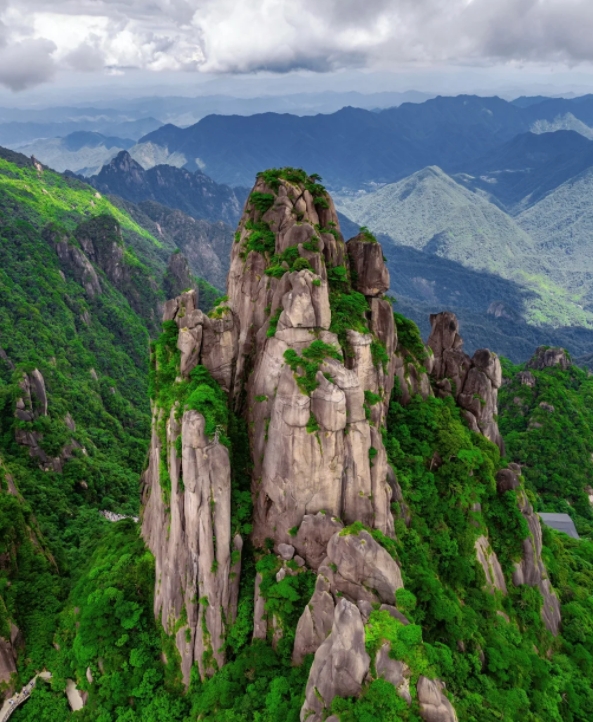
01 Introduction to Sanqingshan Scenic Area
Sanqingshan is located in the northeast of Shangrao City, Jiangxi Province. It is named after the three peaks of Yujing, Yuxu, and Yuhua, which are steep and lofty, just like the highest deities of Taoism, Yuqing, Shangqing, and Taiqing, sitting on the mountaintop. The total area of the scenic area is 229.5 square kilometers, and the main peak, Yujing Peak, is 1819.9 meters above sea level. It is one of the ten highest peaks in Jiangxi Province.
Within the scenic area, thousands of peaks compete in beauty, thousands of valleys rush with water, ancient trees are lush, and rare birds inhabit. It is surrounded by clouds and mist all year round, full of fairy charm. The geological evolution over 1 billion years has formed the magnificent spectacle of towering peaks and deep valleys, known as “the first fairy mountain in Jiangnan.” At the same time, it is also a famous Taoist mountain that has been soaked in human culture for more than 1600 years. In particular, the ancient Taoist architectural complex of Sanqing Palace laid out according to the Later Heaven Bagua is evaluated by the cultural relics research expert group of the State Council as “an open-air museum of ancient Taoist architecture in China.”
Scenic area business cards:
In August 1988, it was approved as a national scenic area by the State Council.
In July 2008, it was included in the World Heritage List by the World Heritage Committee of UNESCO. Sanqingshan officially became a world natural heritage.
In September 2011, it was rated as a national 5A-level tourist scenic area by the National Tourism Administration.
In September 2012, it was approved by UNESCO to join the World Geopark Network.

The evaluation of Sanqingshan by the World Heritage Committee of UNESCO:
Sanqingshan shows unique granite pillars and peaks in a relatively small area. The rich granite shaped stones combined with various vegetation, changing landscapes from near and far, and breathtaking climatic wonders create a unique landscape aesthetic effect in the world and present a fascinating natural beauty.
Sanqingshan shows unique granite pillars and peaks in a relatively small area. The rich granite shaped stones combined with various vegetation, changing landscapes from near and far, and breathtaking climatic wonders create a unique landscape aesthetic effect in the world and present a fascinating natural beauty.
Shot with an ordinary Honor mobile phone. The white balance is not perfect.
Just take a look. The real scene is more beautiful than the photographed picture.
Just take a look. The real scene is more beautiful than the photographed picture.
02 Landscape features of Sanqingshan
The most remarkable feature of Sanqingshan is its granite peak forest landform. 奇峰怪石奇形怪状 and diverse in shape. The uncanny workmanship of nature is amazing. Coupled with changing weather, rich vegetation, diverse organisms, and profound Taoist culture, they jointly form the unique charm of Sanqingshan.
The poet Su Shi wrote in his poem: “Having visited all the Five Sacred Mountains, the most extraordinary scenery is in Sanqingshan.”
The famous essayist Qin Mu wrote after visiting Sanqingshan in 1988: “The hometown of clouds and fog, the gallery of pines and rocks.” The summary is very exquisite.
The poet Su Shi wrote in his poem: “Having visited all the Five Sacred Mountains, the most extraordinary scenery is in Sanqingshan.”
The famous essayist Qin Mu wrote after visiting Sanqingshan in 1988: “The hometown of clouds and fog, the gallery of pines and rocks.” The summary is very exquisite.
World Heritage experts call it:
“The natural museum of granite micro-landforms in the world.”
“The most beautiful granite peak forest on the edge of the Western Pacific.”
“The granite peak forest with the densest and most diverse forms known in granite landforms in the world.”
“The natural museum of granite micro-landforms in the world.”
“The most beautiful granite peak forest on the edge of the Western Pacific.”
“The granite peak forest with the densest and most diverse forms known in granite landforms in the world.”
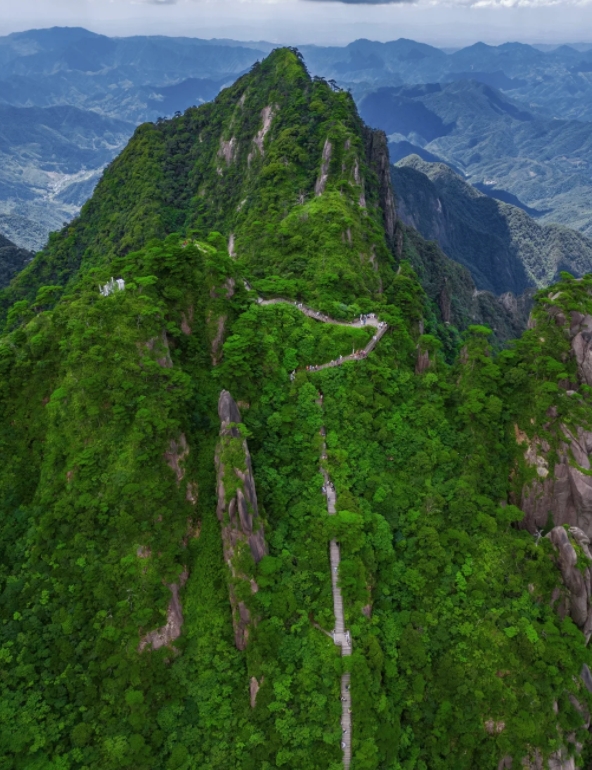
These praises are very abstract. Only by personally walking through every corner of Sanqingshan and enjoying its peerless landscape can one understand.
There are two most representative landscapes in Sanqingshan: Giant Python Emerges from the Mountain and Goddess of the East.
Other main natural landscapes include: Old Taoist Worshiping the Moon, Pulo Roaring to the Sky, Jade Rabbit Running to the Moon, Child Prodigy Carrying a Pine Tree, Guanyin Sending Off a Child, Monkey King Watching the Treasure, National Uncle Realizing the Dao, Civet Cat Waiting for a Mouse, Fox Gnawing Chicken, Penguins Presenting Peaches, Ge Hong Making Pills, Fairy Drying Shoes, Carefree Tang Monk, Little Chick Hatching, and so on.
There are also various flowers blooming in different seasons, such as magnolias, rhododendrons, alpinia flowers, pleione bulbs, etc., and various creatures encountered unexpectedly, such as squirrels, tragopans, etc.
There are two most representative landscapes in Sanqingshan: Giant Python Emerges from the Mountain and Goddess of the East.
Other main natural landscapes include: Old Taoist Worshiping the Moon, Pulo Roaring to the Sky, Jade Rabbit Running to the Moon, Child Prodigy Carrying a Pine Tree, Guanyin Sending Off a Child, Monkey King Watching the Treasure, National Uncle Realizing the Dao, Civet Cat Waiting for a Mouse, Fox Gnawing Chicken, Penguins Presenting Peaches, Ge Hong Making Pills, Fairy Drying Shoes, Carefree Tang Monk, Little Chick Hatching, and so on.
There are also various flowers blooming in different seasons, such as magnolias, rhododendrons, alpinia flowers, pleione bulbs, etc., and various creatures encountered unexpectedly, such as squirrels, tragopans, etc.
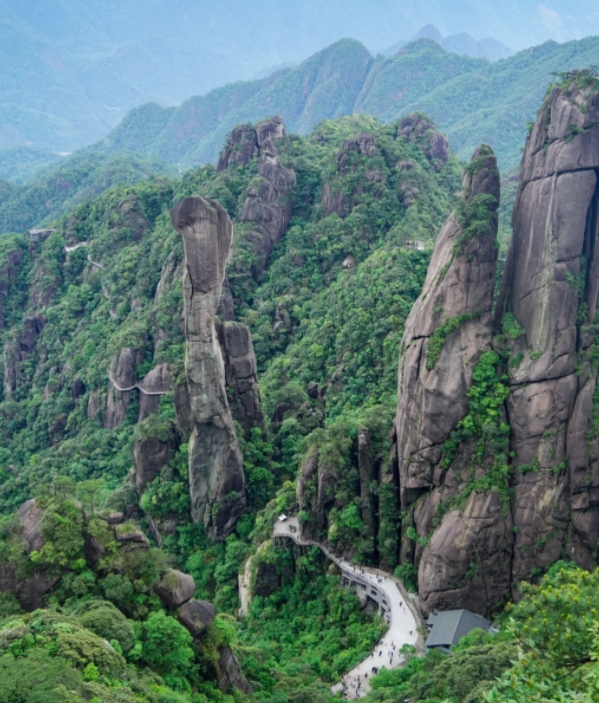
Sanqingshan combines the majesty of Mount Tai, the steepness of Mount Hua, the clouds and mist of Mount Hengshan, the waterfalls of Mount Lushan, and the strange pines of Mount Huangshan. Here there are rich and diverse landforms and peculiar and magnificent landscapes. The “Goddess of the East” shows the pure, dignified, gentle and virtuous oriental charm. The “Giant Python Emerges from the Mountain” is full of the tension of life, showing the power of nature’s creation.
Many people say that the Goddess Peak looks like a young girl. I don’t think so. No matter how you look at it, it looks like a middle-aged mature woman, exuding pure charm and conforming to traditional oriental aesthetics. Many people also say that it looks like an old woman, a middle-aged woman, and a young girl from different angles. This is too far-fetched. Just look at the best angle. As for the previous written materials that said it was the Goddess of Spring in charge of spring, etc., it is ridiculously made up. Fortunately, people don’t say that anymore.
The best angle to view the Goddess Peak is on the plank road from Penguins Presenting Peaches to Goddess Guesthouse. Looking carefully, it is the most vivid. You can clearly see that the hairstyle is short hair. There is also a hairpin near the top of the forehead, a nose, a mouth, and clothes similar to those worn in ancient times. It is relatively close to the traditional virtuous female image.
Many people say that the Goddess Peak looks like a young girl. I don’t think so. No matter how you look at it, it looks like a middle-aged mature woman, exuding pure charm and conforming to traditional oriental aesthetics. Many people also say that it looks like an old woman, a middle-aged woman, and a young girl from different angles. This is too far-fetched. Just look at the best angle. As for the previous written materials that said it was the Goddess of Spring in charge of spring, etc., it is ridiculously made up. Fortunately, people don’t say that anymore.
The best angle to view the Goddess Peak is on the plank road from Penguins Presenting Peaches to Goddess Guesthouse. Looking carefully, it is the most vivid. You can clearly see that the hairstyle is short hair. There is also a hairpin near the top of the forehead, a nose, a mouth, and clothes similar to those worn in ancient times. It is relatively close to the traditional virtuous female image.
03 Regrets of Sanqingshan
Sanqingshan is not without regrets.
First, it is a world natural heritage site, not a dual natural and cultural heritage site. In fact, with its rich and complete Taoist historical buildings and cultural relics that have continued for thousands of years, it is fully qualified. Perhaps the cultural connotations are overlooked due to the strong attention to natural landscapes. Perhaps it is because Taoism is traditional Chinese culture and experts are not interested. It can be seen from the comments of World Heritage experts that there is no mention of human cultural relics. What a pity. I hope it can be applied for as a dual heritage site in the future.
Second, it has been in the shadow of Huangshan Mountain for a long time. In terms of stone peaks, strange pines, and clouds and mist, it is very similar to Huangshan Mountain! ~ So much so that some people say: Comparing with Huangshan Mountain is the life-long destiny of Sanqingshan. In fact, in the early promotional materials, it was directly said that Sanqingshan is called “Little Huangshan Mountain.” Of course, being called “Little Huangshan Mountain” itself is also a compliment and affirmation to Sanqingshan.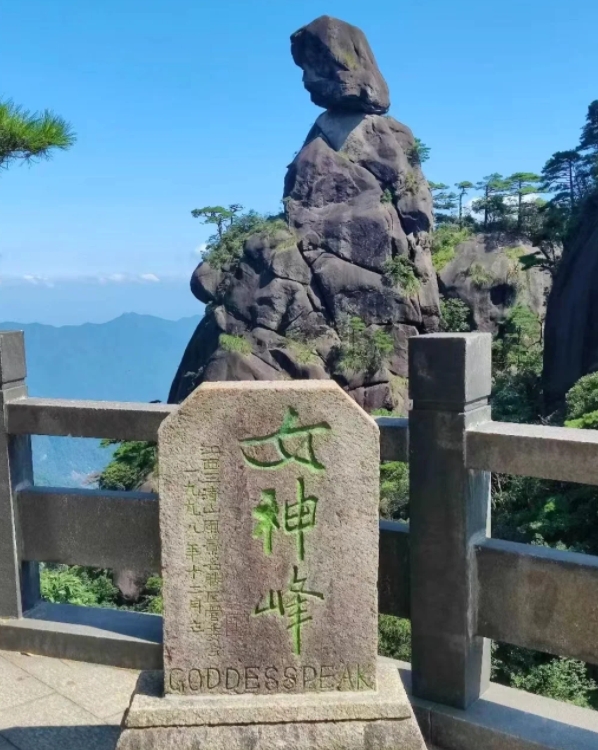
According to the author’s observation and records, in recent years, Sanqingshan has no longer mentioned the term “Little Huangshan Mountain.” Only Sanqingshan is emphasized. The beauty and charm of Huangshan Mountain are universally recognized. The promotional slogan of Huangshan Mountain is extracted from the words of Xu Xiake, which is the familiar sentence “After returning from the Five Sacred Mountains, one does not need to look at other mountains. After returning from Huangshan Mountain, one does not need to look at other mountains.” There is also an unofficial but widely spread sentence called: After experiencing Huangshan Mountain, there are no other mountains in the world. This sentence also truly has a domineering air. After all, below the snow line, Huangshan Mountain is dominant. And Sanqingshan has to find its own way. It is said that a Chinese language teacher once proposed an eight-character promotional slogan: There is no limit to the heart. There are mountains beyond mountains. – Sanqingshan, Jiangxi. Such promotional language is completely different from the domineering air of Huangshan Mountain. It neither follows Huangshan Mountain nor lives in its shadow, nor competes head-on with Huangshan Mountain (unnecessary and impossible to compete head-on). It shows a humble and cautious broad realm. Especially on a clear day, when looking far into the distance from a high place, the distant mountains are like indigo, stretching layer by layer. It really gives a feeling of no limit to the heart. There is a sky beyond the sky, mountains beyond mountains, and people beyond people. What wonderful words. But after consulting a lot of materials, I haven’t found the official use of these eight characters as cultural propaganda.
Second, it has been in the shadow of Huangshan Mountain for a long time. In terms of stone peaks, strange pines, and clouds and mist, it is very similar to Huangshan Mountain! ~ So much so that some people say: Comparing with Huangshan Mountain is the life-long destiny of Sanqingshan. In fact, in the early promotional materials, it was directly said that Sanqingshan is called “Little Huangshan Mountain.” Of course, being called “Little Huangshan Mountain” itself is also a compliment and affirmation to Sanqingshan.

According to the author’s observation and records, in recent years, Sanqingshan has no longer mentioned the term “Little Huangshan Mountain.” Only Sanqingshan is emphasized. The beauty and charm of Huangshan Mountain are universally recognized. The promotional slogan of Huangshan Mountain is extracted from the words of Xu Xiake, which is the familiar sentence “After returning from the Five Sacred Mountains, one does not need to look at other mountains. After returning from Huangshan Mountain, one does not need to look at other mountains.” There is also an unofficial but widely spread sentence called: After experiencing Huangshan Mountain, there are no other mountains in the world. This sentence also truly has a domineering air. After all, below the snow line, Huangshan Mountain is dominant. And Sanqingshan has to find its own way. It is said that a Chinese language teacher once proposed an eight-character promotional slogan: There is no limit to the heart. There are mountains beyond mountains. – Sanqingshan, Jiangxi. Such promotional language is completely different from the domineering air of Huangshan Mountain. It neither follows Huangshan Mountain nor lives in its shadow, nor competes head-on with Huangshan Mountain (unnecessary and impossible to compete head-on). It shows a humble and cautious broad realm. Especially on a clear day, when looking far into the distance from a high place, the distant mountains are like indigo, stretching layer by layer. It really gives a feeling of no limit to the heart. There is a sky beyond the sky, mountains beyond mountains, and people beyond people. What wonderful words. But after consulting a lot of materials, I haven’t found the official use of these eight characters as cultural propaganda.
04 Tour suggestions for Sanqingshan
Transportation: There is no direct high-speed rail. You need to transfer by bus in Yushan, Shangrao, or Wuyuan high-speed rail stations. Or you can take a group tour and take a tourist bus directly, or drive directly. Expressways and mountain winding roads are very convenient for transportation.
Scenic area ticket: 150 yuan. Scenic area cableway: 125 yuan for a round trip.
Tourist routes: There are mainly scenic areas such as Nanqingyuan, Wanshouyuan, West Coast, Sunshine Coast, and Sanqing Palace. Sanqingshan has extremely complete high-altitude plank roads! ~ Amazing! The total length of the plank roads is about 12 kilometers in total. This is one of the best among mountain scenic areas in the country! Of course, there are also many steps. For the elderly with limited mobility or poor physical strength, it is also very friendly. You don’t have to climb very high. You can also see beautiful scenery by walking on the plank roads. If you want to fully explore everywhere, then you need physical strength.

The most sincere suggestion: Don’t just follow an online guide and map. Personally, I think maps are not very useful, let alone the route text instructions in so-called guides. Because Sanqingshan is three-dimensional, and there are many stores and turns at intersections. Although there are signs, according to my actual work experience, most people can’t figure out the directions. You must hire a tour guide to lead the way. In this way, you can discuss according to your own physical ability, reasonably design the route, have guidance and explanations, and avoid spending a lot of energy looking for the way and walking around in confusion and taking unnecessary detours.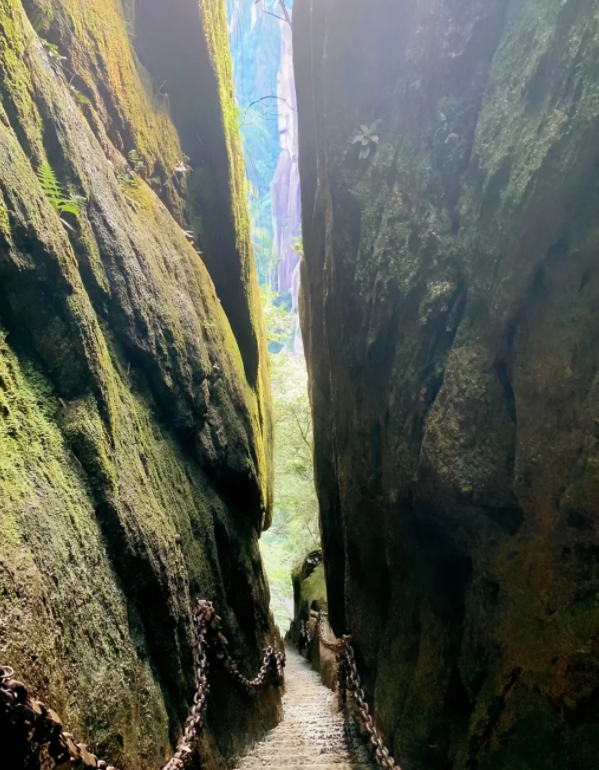

Sanqingshan has two cableways, the Jinsha Cableway in the east and the Waishuangxi Cableway in the south. Many tourists walk around without a tour guide and end up going in the wrong direction, wasting extra time and energy and having to take a taxi back to the original parking place at a cost. Sincerely suggest hiring a tour guide.
Weather: It is best to check the weather in advance and design your itinerary. If you come casually and encounter bad weather, there is no need to be in a bad mood. Because there are always some rainy days and foggy days in Sanqingshan all year round when everything is white and you can’t see clearly.
Number of tourists: During the peak season in spring, on Golden Week holidays like May Day and National Day, and on weekends and other peak tourist periods, be mentally prepared for queuing for the cableway.
Finally, let’s enjoy the beautiful scenery of Sanqingshan: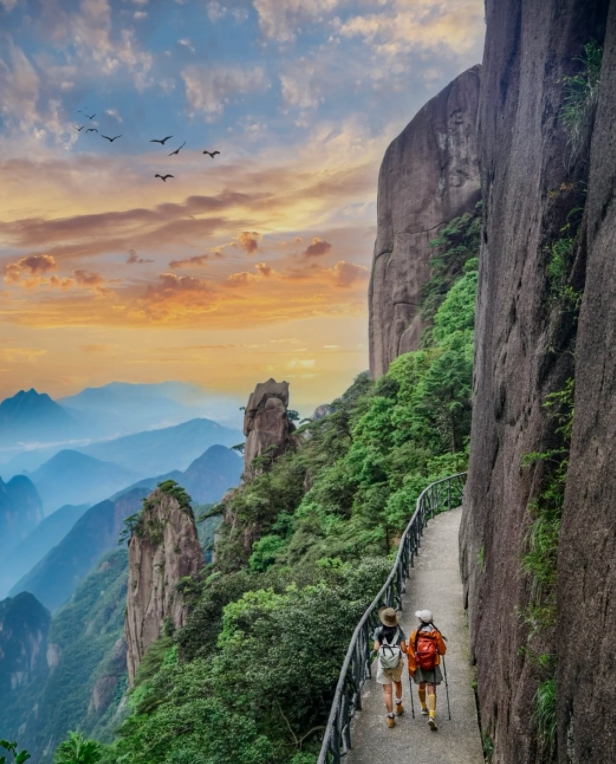
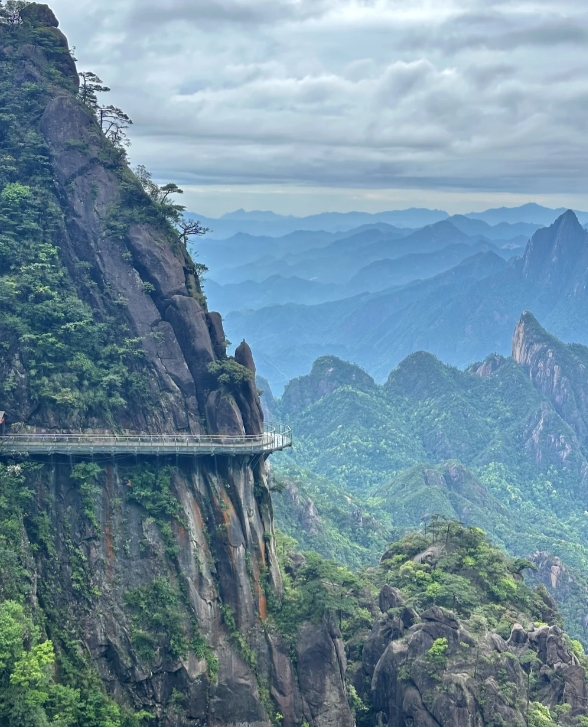
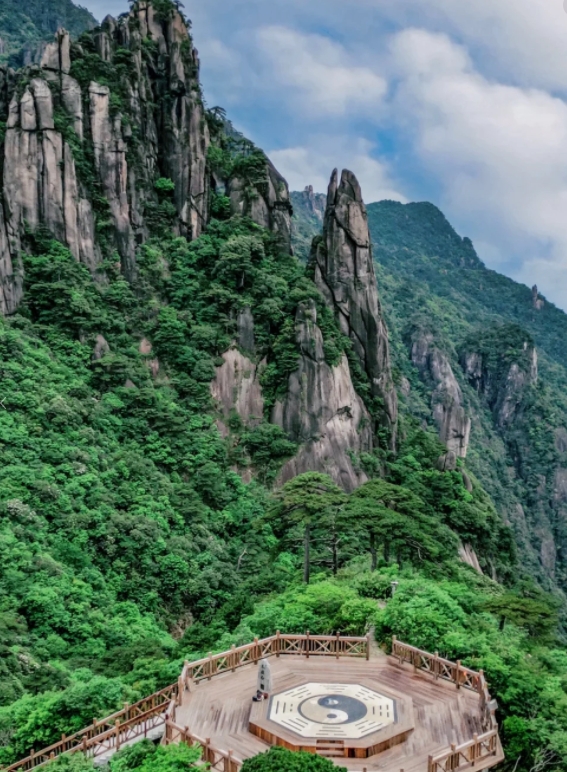
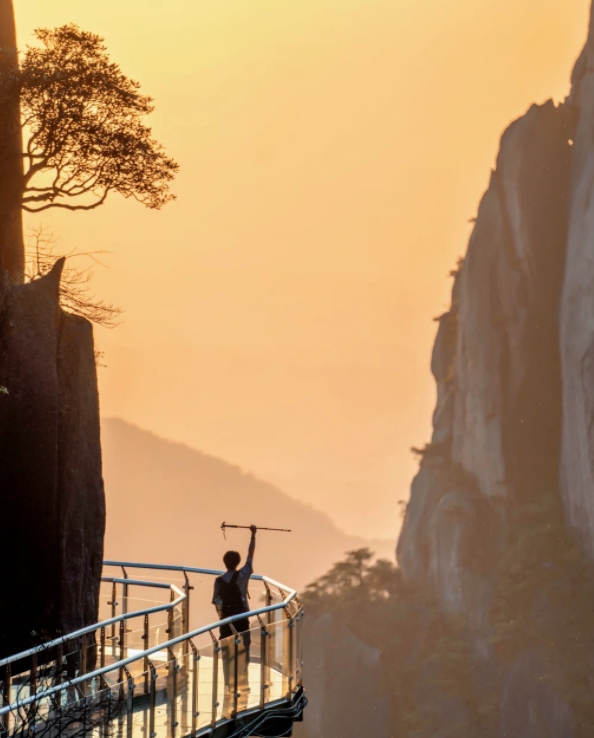
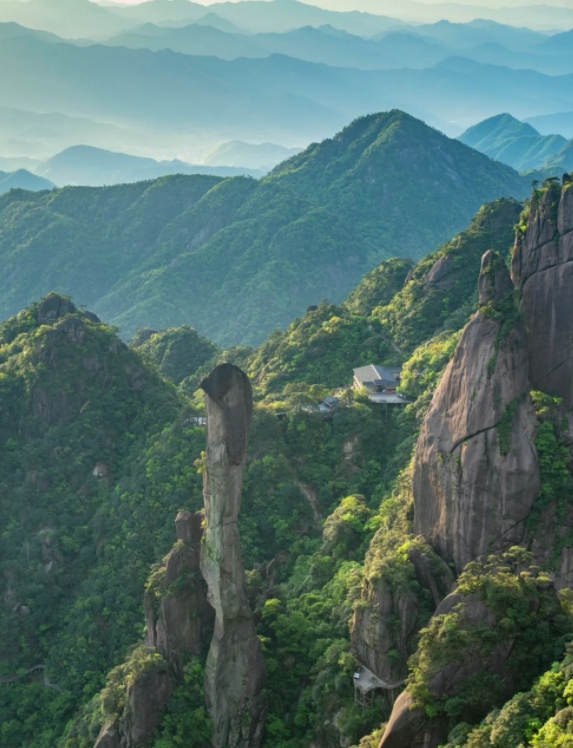





When you come to Jiangxi, you must come to Sanqingshan once! ~
English official website:Tidy up late at night: Smooth routes and time for Sanqingshan!